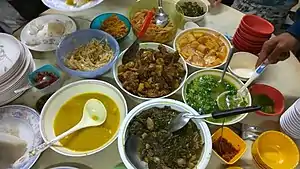Mizo Culture is the culture of the Mizo people. Mizo culture is rooted in the arts and ways of life of Mizos in India, Bangladesh and Myanmar
Mizo people
The Mizo people (Mizo: Mizo hnam) are an ethnic group native to north-eastern India, western Burma (Myanmar) and eastern Bangladesh; this term covers several ethnic peoples who speak various Kuki-Chin languages. Though the term Mizo is often used to name an overall ethnicity, it is an umbrella term to denote the various clans, such as the Hmar, Ralte, Lai, Lusei etc. A number of dialects are still spoken under the umbrella of Mizo;[1]
Mizoram Language
Mizo is the official language of Mizoram, along with English. Mizo language, or Mizo ṭawng, is a language belonging to the Sino-Tibetan family of languages, spoken natively by the Mizo people in Mizoram states of India and Chin State in Burma.[2]
Mizo Literature
Mizo literature is the literature written in Mizo ṭawng, the principal language of the Mizo peoples, which has both written and oral traditions. It has undergone a considerable change in the 20th century. The language developed mainly from the Lushai language, with significant influence from Pawi language, Paite language and Hmar language, especially at the literary level.[3]
Mizo Music
Mizo folk music consists of vocals (singing) accompanied by traditional drums, gong and other native percussion instruments.[4]
Mizo Folk Dance
Mizo people have a number of dances which are accompanied with few musical instrument like the gong and drum. The different dances of Mizoram are Cheraw dance, Khuallam, Chheihlam, Chailam, Tlanglam, Sarlamkai and Chawnglaizawn.[5]
Mizo Cuisine

Mizoram shares characteristics to other regions of Northeast India and North India. The staple food of most of the Mizo people is rice, with meat and vegetables served on the side, ranging from the homely bai, a simple vegetable stew, non veg stew with sesame, garlic, onion and herbs.[6]
References
- ↑ KHAWTINKHUMA, VANTHUAMA. "MEMORANDUM SUBMITTED TO HIS MAJESTY'S GOVERNMENT BY MIZO UNION". ZOLENTHE.NET. Archived from the original on 7 February 2012. Retrieved 17 August 2012.
- ↑ Lalthangliana, B., 'Mizo tihin ṭawng a nei lo' tih kha, see also Matisoff, 'Language names' section
- ↑ Lalthangliana, B., 'Mizo tihin ṭawng a nei lo' tih kha
- ↑ B. Thangliana, Mizo Literature, 1993, p.76
- ↑ Lianhmingthanga, F. Mizo Nun hlui. MBSE.
- ↑ Mizar, Shilpa (30 June 2010). "Mizo by nature". The Hindu. Retrieved 6 December 2018.